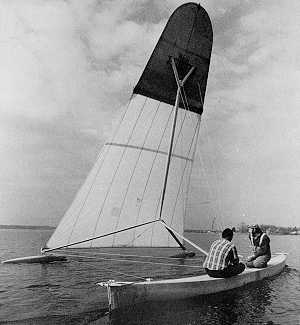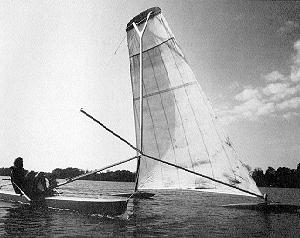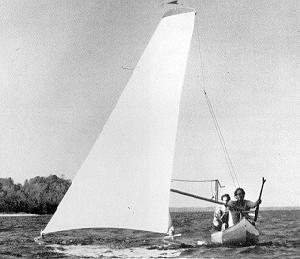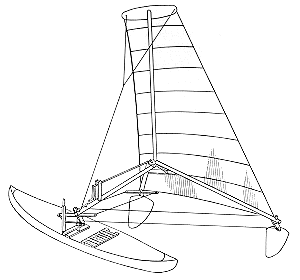Mr Smith's Amazing Sailboats
The Monomarans
(Section 3 of 6)
Monomaran I
With the Aerohydrofoil being, um, a qualified success, a new
design that overcame the low-wind speed problems and the excessive draught inherent with
the Aerohydrofoil design was developed. This design was called the Monomaran as it was a
monohull but which had some of the attributes of a multihull.
Still using the reversible proa approach, the two windward foils in the Aerohydrofoil
concept were replaced by a long and slender displacement hull. This hull was
asymmetrical and had rudders incorporated at both ends. The use of a large
inclined sailrig was retained, as was the tetrahedral spaceframe. Stability was
provided by two small swiveling waterskis arranged leeward of the hull, at the tips of the
tetrahedral where the base of the sail was also attached. Swiveling the entire
spaceframe about the hull oriented the sail, while steering the craft was done by the two
rudders. Handling proved to be difficult however.

The Monomaran solved somewhat the problems experienced with the
Aerohydrofoil. Draft was just 18 inches for a 3 person crew, low wind performance
was improved, though at the cost of high wind performance, as the physics of displacement
hull drag just couldn't be avoided.
Monomaran II
The first Monomaran was Bernard's last sailboat whilst he was
at the Naval Research Center. His retirement however saw the arrival in 1975 of
Frank Delano who joined with Bernard to develop a second and better version of the
Monomaran. In their new design, some of the compromises that had been placed on the
monomaran by it being a reversible proa were done away with. Now the monomaran used
a normal symmetrical displacement hull, one with a true bow and a true stern. The
arrangement of the inclined rig and waterskis was still there, but applied in a different
way. In this design, the rig could swivel around the bow of the craft as it tacked.

To tack, the hull was steered across the eye of the wind,
the sail on the rig would then billow inwards (ie towards the hull). Aerodynamic
pressure would then cause the sailrig to swivel around the front of the hull, till it
reached the other side of the hull. A restraining line was attached from the bow to
the sailrig to ensure it didn't swivel around too far!
Though Monomaran II was better than its predecessor and could reach boat speeds equal to
that of the wind, problems still existed. The tacking maneuver wasn't always
successful, as the sailrig's mass wasn't great enough to ensure it always came about when
tacking. The solution of adding mass to the sailrig would mean affecting displacement and
thus speed. Another design iteration was needed.
Monomaran III
Bernard and Frank's second joint monomaran design took another approach
to control. This craft, like the first Monomaran, was a reversible proa, but the two
stabilizing waterskis were now replaced by buoyant hydrofoils, cannibalized from the
manned Aerohydrofoil.

These two hydrofoils did the steering and control for the Monomaran. A system of cables connecting the foils to a single control lever allowed for the foils to turn either in same direction or in opposite directions as required. Moving the foils in unison altered the orientation of the sail in relation to the hull. Moving the foils differentially steered the craft.
Note that all of the power and control for the Monomaran were in the sail and the two foils attached to tetrahedral framework - the monohull (actually a double-ended canoe) simply had a load-carrying role for the crew and was "towed" behind by the sailrig.

This final Monomaran was a major improvement on the
previous designs and it could reach 20 knots in just 20 knots of wind. It was
a tidy design with a nice synthesis of components. Velocity however was a factor
with the control system, as speed was needed to allow the foils to be effective.
Another aspect to the Monomaran III was that the sails and foils had to be
effective in both directions, and thus were compromised in their performance.